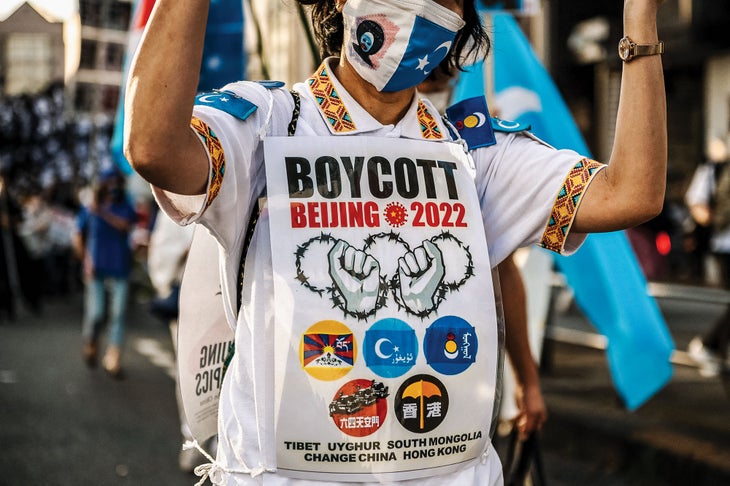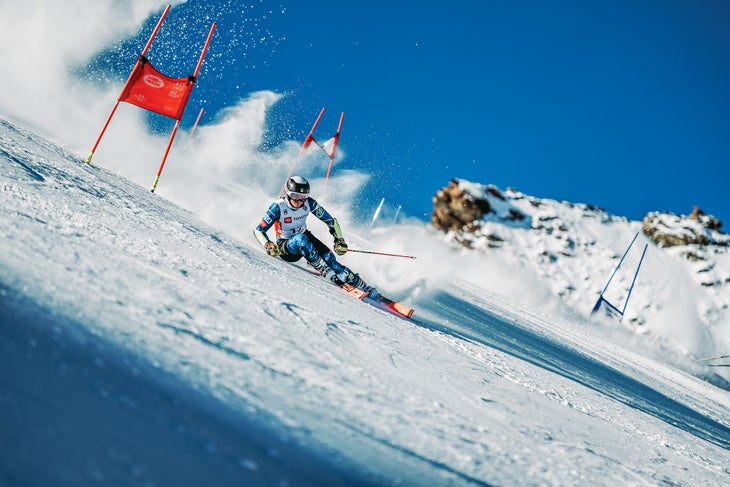Products You May Like
The U.S. Ski Team will travel across the globe to Beijing, China, in early February in pursuit of Olympic glory, to compete at a Winter Olympics that will be unlike any of the previous 23, which began with the inaugural games in Chamonix in 1924, nearly 100 years ago.
When the XXIV Olympic Winter Games begin on February 4, the world’s fastest ski racers will descend the unfamiliar slopes at China’s National Alpine Skiing Center in Yanqing, located about 55 miles northwest of Beijing. (The Paralympic Games will follow from March 4-13.) Having hosted the 2008 Summer Games, Beijing is the first city to host both the Summer and Winter Olympics. Considering that both the men’s and women’s test events, scheduled for February 2020, were canceled due to coronavirus travel restrictions, racers will be accessing and deciphering the courses and terrain for the first time. Stringent coronavirus countermeasures, unknown venues, artificial snow, and political overtones will make this a particularly challenging world stage.

Still, U.S. superstar Mikaela Shiffrin intends to race in all five individual alpine skiing events at the Games, similar to the strategy she used during the PyeongChang Games in 2018, although one that was thrown off by curveballs from Mother Nature and a revamped race schedule. The three-time Olympic medalist has been keeping a close eye on the varying weather patterns in Yanqing.
“It could be very similar in China. If there are schedule changes, I’m hoping to roll with the punches without exerting as much energy as four years ago,” said Shiffrin, who won gold in GS and silver in Alpine Combined in PyeongChang. “It’s easy to say, but it’s a lot harder to do when you’re there and stressed.”
Ryan Cochran-Siegle, who is rebounding from a neck injury suffered in a downhill crash in Kitzbühel, Austria, in January 2021, says he is trying to embrace the unknown characteristics of 7,212-foot Xiaohaituo Mountain, home to the alpine skiing events. Ski enthusiasts all remember the ‘Chinese downhill’ scene from the 1980s ski film “Hot Dog,” however, China’s first downhill racing track is nothing to joke about, with a maximum gradient of 69 percent and varied terrain designed to test skiers’ speed, control, and technical chops.
“With where I’m at in my career and how I’ve developed, I honestly feel like that could be an advantage,” said Cochran-Siegle, a Vermont racer seeking his second Olympic bid. “On new slopes, I’ve actually been able to perform well.”

Tech specialist Paula Moltzan looks forward to her first opportunity to wear red, white, and blue at an Olympics, despite the noise surrounding these Games.
“There are a lot of questions about Beijing on both the socioeconomic and the snow conditions sides—no one knows what we’re in for,” Moltzan said. “They don’t get a lot of snowfall there, so we expect it to be relatively dry.”
Despite course challenges and travel restrictions that have led to many of the changes at this year’s games, the IOC and International Ski Federation (FIS) have also added seven new events and made some progress towards gender equality among athletes.
Four of the new events are mixed-gender team events, including freestyle aerials, snowboardcross, ski jumping, and short-track speed skating, increasing the total to 109 medal events, the largest in Winter Olympics history.
Additionally, new high-flying events include men’s and women’s freeski big air, which will be held at the Shougang Big Air venue, an enormous ramp constructed at a former Beijing industrial complex. American-born and -trained Olympic favorite Eileen Gu will have the chance to make history on this stage when she competes for her mother’s native China.
While she and other athletes attempt to focus on landing airborne maneuvers, racing at top speed, and navigating tricky courses, they will also have to cope with the political overtones of a U.S.-led diplomatic boycott.
Taking a firm stance in protest of China’s numerous human rights abuses—namely ongoing genocide and crimes against humanity in Xinjiang—President Biden declared a diplomatic boycott of the Beijing Winter Games on December 6. While this doesn’t prevent or hinder the athletes from competing, it does mean that U.S. authorities will not participate in any aspects of the Games’ ceremonies and pageantry, most notably the opening ceremony, which is traditionally attended by heads of state and leading government officials.
White House press secretary Jen Psaki noted that Team USA athletes have the full support of the administration, however. Australia, Great Britain, and Canada have also declared their own diplomatic boycotts.
“The Games have the mission to unite the world in a sporting and peaceful competition, says IOC president Thomas Bach. “They are to be above all other conflicts, no matter where they take place.”
As for who will be competing for the Olympic medals, the qualification process is complex. Athletes need to earn quota spots for the United States in addition to meeting the selection criteria that will allow them to fill those spots. The qualification period for alpine and freestyle skiing ended on January 16, after which the U.S. Olympic and Paralympic Ski Team were named.
While all eyes will be on big names like Shiffrin and freeskiing phenom Eileen Gu, there are plenty of other athletes to watch for, including racers Moltzan and Cochran-Siegle, adaptive monoskier Ravi Drugan and 17-year-old mogul star Kai Owens, who all remind us that on any given Sunday, anyone can be an Olympian.
